University Business Law Case Study: Australian Consumer Law Analysis
VerifiedAdded on 2022/12/03
|11
|2004
|118
Case Study
AI Summary
This case study analyzes a Business Law scenario focusing on the Australian Consumer Law (ACL). Part A examines the benefits of the ACL and the advantages of Section 18 regarding misleading or deceptive conduct. Part B presents a scenario involving a restaurant owner and a pizza oven manufacturer. The analysis addresses whether the manufacturer and its manager are liable for breaches of consumer guarantees, considering issues of misrepresentation and defective goods. The study explores relevant legal principles, including the application of ACL sections, common law precedents, and the concept of manufacturer liability for defective products. The conclusion determines whether the manufacturer can be held liable under the ACL based on the provided facts and legal arguments.
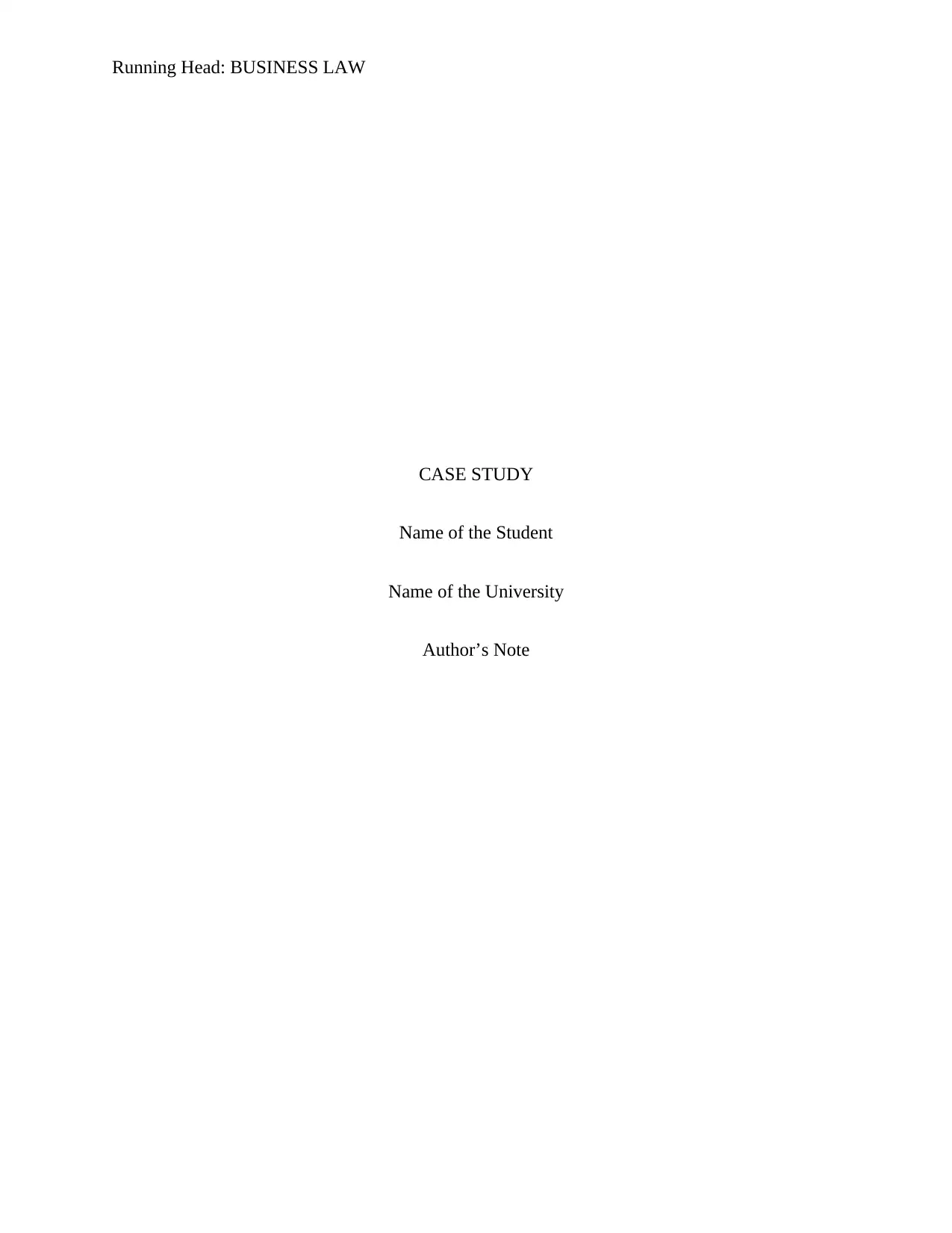
Running Head: BUSINESS LAW
CASE STUDY
Name of the Student
Name of the University
Author’s Note
CASE STUDY
Name of the Student
Name of the University
Author’s Note
Paraphrase This Document
Need a fresh take? Get an instant paraphrase of this document with our AI Paraphraser
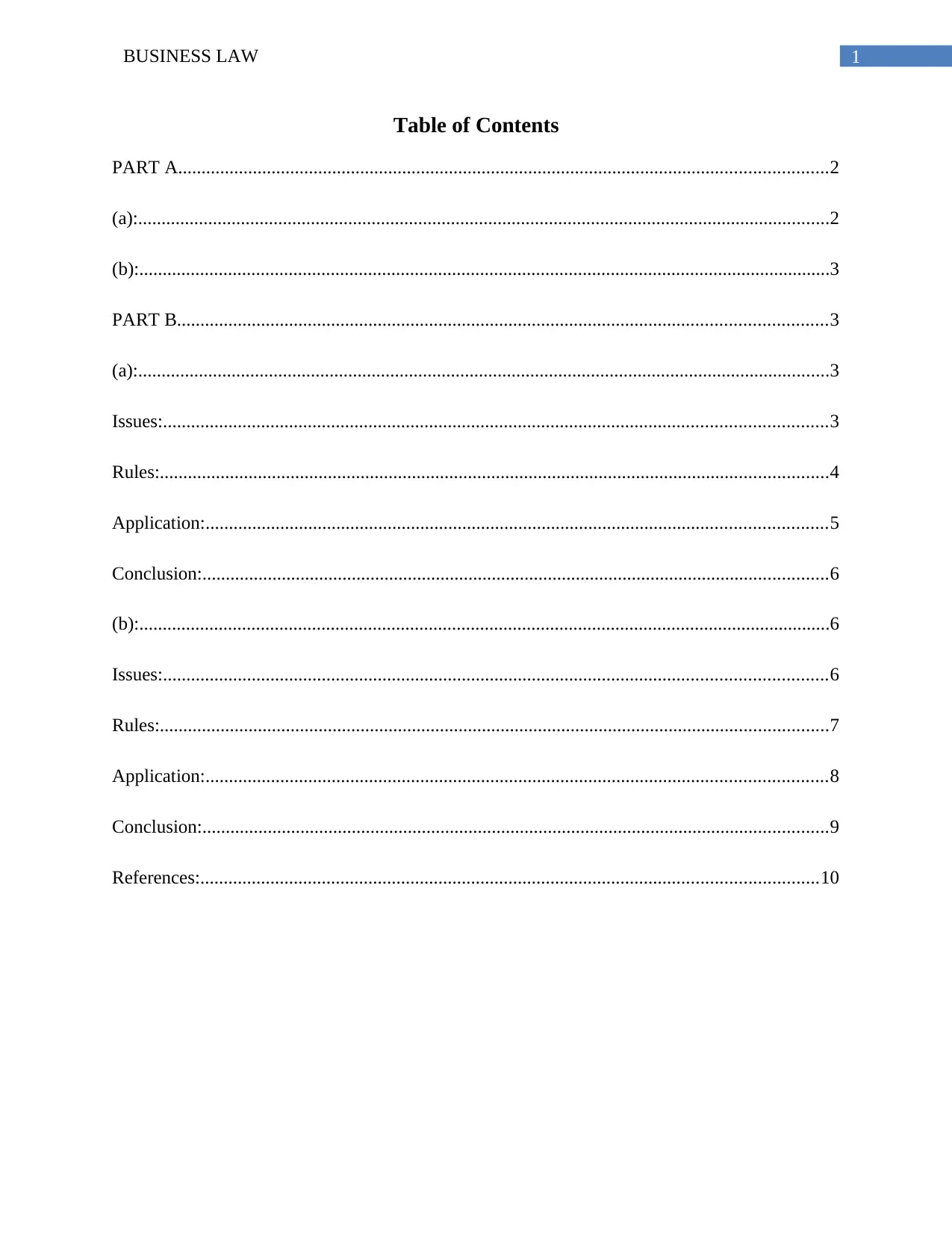
1BUSINESS LAW
Table of Contents
PART A...........................................................................................................................................2
(a):....................................................................................................................................................2
(b):....................................................................................................................................................3
PART B...........................................................................................................................................3
(a):....................................................................................................................................................3
Issues:..............................................................................................................................................3
Rules:...............................................................................................................................................4
Application:.....................................................................................................................................5
Conclusion:......................................................................................................................................6
(b):....................................................................................................................................................6
Issues:..............................................................................................................................................6
Rules:...............................................................................................................................................7
Application:.....................................................................................................................................8
Conclusion:......................................................................................................................................9
References:....................................................................................................................................10
Table of Contents
PART A...........................................................................................................................................2
(a):....................................................................................................................................................2
(b):....................................................................................................................................................3
PART B...........................................................................................................................................3
(a):....................................................................................................................................................3
Issues:..............................................................................................................................................3
Rules:...............................................................................................................................................4
Application:.....................................................................................................................................5
Conclusion:......................................................................................................................................6
(b):....................................................................................................................................................6
Issues:..............................................................................................................................................6
Rules:...............................................................................................................................................7
Application:.....................................................................................................................................8
Conclusion:......................................................................................................................................9
References:....................................................................................................................................10
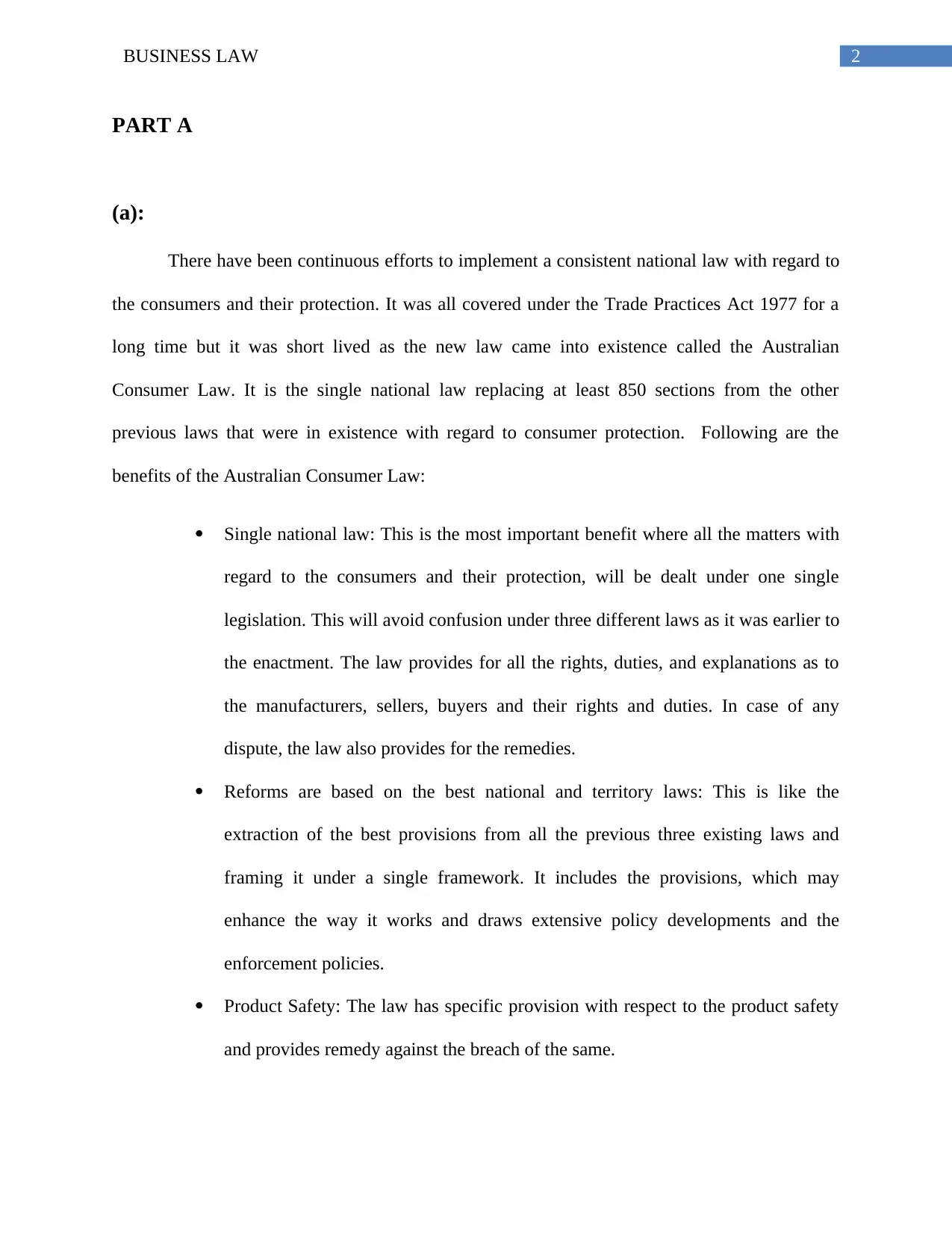
2BUSINESS LAW
PART A
(a):
There have been continuous efforts to implement a consistent national law with regard to
the consumers and their protection. It was all covered under the Trade Practices Act 1977 for a
long time but it was short lived as the new law came into existence called the Australian
Consumer Law. It is the single national law replacing at least 850 sections from the other
previous laws that were in existence with regard to consumer protection. Following are the
benefits of the Australian Consumer Law:
Single national law: This is the most important benefit where all the matters with
regard to the consumers and their protection, will be dealt under one single
legislation. This will avoid confusion under three different laws as it was earlier to
the enactment. The law provides for all the rights, duties, and explanations as to
the manufacturers, sellers, buyers and their rights and duties. In case of any
dispute, the law also provides for the remedies.
Reforms are based on the best national and territory laws: This is like the
extraction of the best provisions from all the previous three existing laws and
framing it under a single framework. It includes the provisions, which may
enhance the way it works and draws extensive policy developments and the
enforcement policies.
Product Safety: The law has specific provision with respect to the product safety
and provides remedy against the breach of the same.
PART A
(a):
There have been continuous efforts to implement a consistent national law with regard to
the consumers and their protection. It was all covered under the Trade Practices Act 1977 for a
long time but it was short lived as the new law came into existence called the Australian
Consumer Law. It is the single national law replacing at least 850 sections from the other
previous laws that were in existence with regard to consumer protection. Following are the
benefits of the Australian Consumer Law:
Single national law: This is the most important benefit where all the matters with
regard to the consumers and their protection, will be dealt under one single
legislation. This will avoid confusion under three different laws as it was earlier to
the enactment. The law provides for all the rights, duties, and explanations as to
the manufacturers, sellers, buyers and their rights and duties. In case of any
dispute, the law also provides for the remedies.
Reforms are based on the best national and territory laws: This is like the
extraction of the best provisions from all the previous three existing laws and
framing it under a single framework. It includes the provisions, which may
enhance the way it works and draws extensive policy developments and the
enforcement policies.
Product Safety: The law has specific provision with respect to the product safety
and provides remedy against the breach of the same.
⊘ This is a preview!⊘
Do you want full access?
Subscribe today to unlock all pages.

Trusted by 1+ million students worldwide
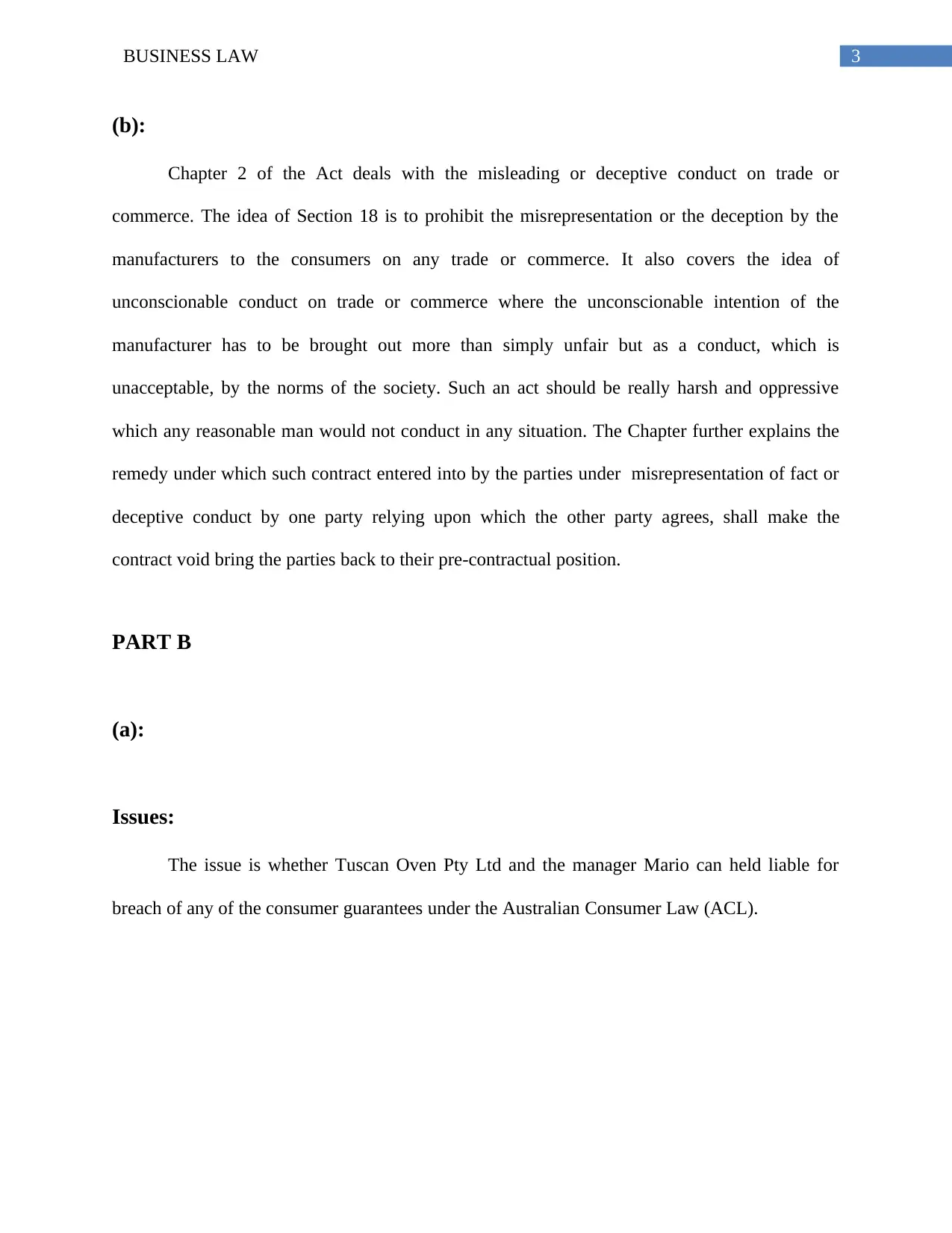
3BUSINESS LAW
(b):
Chapter 2 of the Act deals with the misleading or deceptive conduct on trade or
commerce. The idea of Section 18 is to prohibit the misrepresentation or the deception by the
manufacturers to the consumers on any trade or commerce. It also covers the idea of
unconscionable conduct on trade or commerce where the unconscionable intention of the
manufacturer has to be brought out more than simply unfair but as a conduct, which is
unacceptable, by the norms of the society. Such an act should be really harsh and oppressive
which any reasonable man would not conduct in any situation. The Chapter further explains the
remedy under which such contract entered into by the parties under misrepresentation of fact or
deceptive conduct by one party relying upon which the other party agrees, shall make the
contract void bring the parties back to their pre-contractual position.
PART B
(a):
Issues:
The issue is whether Tuscan Oven Pty Ltd and the manager Mario can held liable for
breach of any of the consumer guarantees under the Australian Consumer Law (ACL).
(b):
Chapter 2 of the Act deals with the misleading or deceptive conduct on trade or
commerce. The idea of Section 18 is to prohibit the misrepresentation or the deception by the
manufacturers to the consumers on any trade or commerce. It also covers the idea of
unconscionable conduct on trade or commerce where the unconscionable intention of the
manufacturer has to be brought out more than simply unfair but as a conduct, which is
unacceptable, by the norms of the society. Such an act should be really harsh and oppressive
which any reasonable man would not conduct in any situation. The Chapter further explains the
remedy under which such contract entered into by the parties under misrepresentation of fact or
deceptive conduct by one party relying upon which the other party agrees, shall make the
contract void bring the parties back to their pre-contractual position.
PART B
(a):
Issues:
The issue is whether Tuscan Oven Pty Ltd and the manager Mario can held liable for
breach of any of the consumer guarantees under the Australian Consumer Law (ACL).
Paraphrase This Document
Need a fresh take? Get an instant paraphrase of this document with our AI Paraphraser
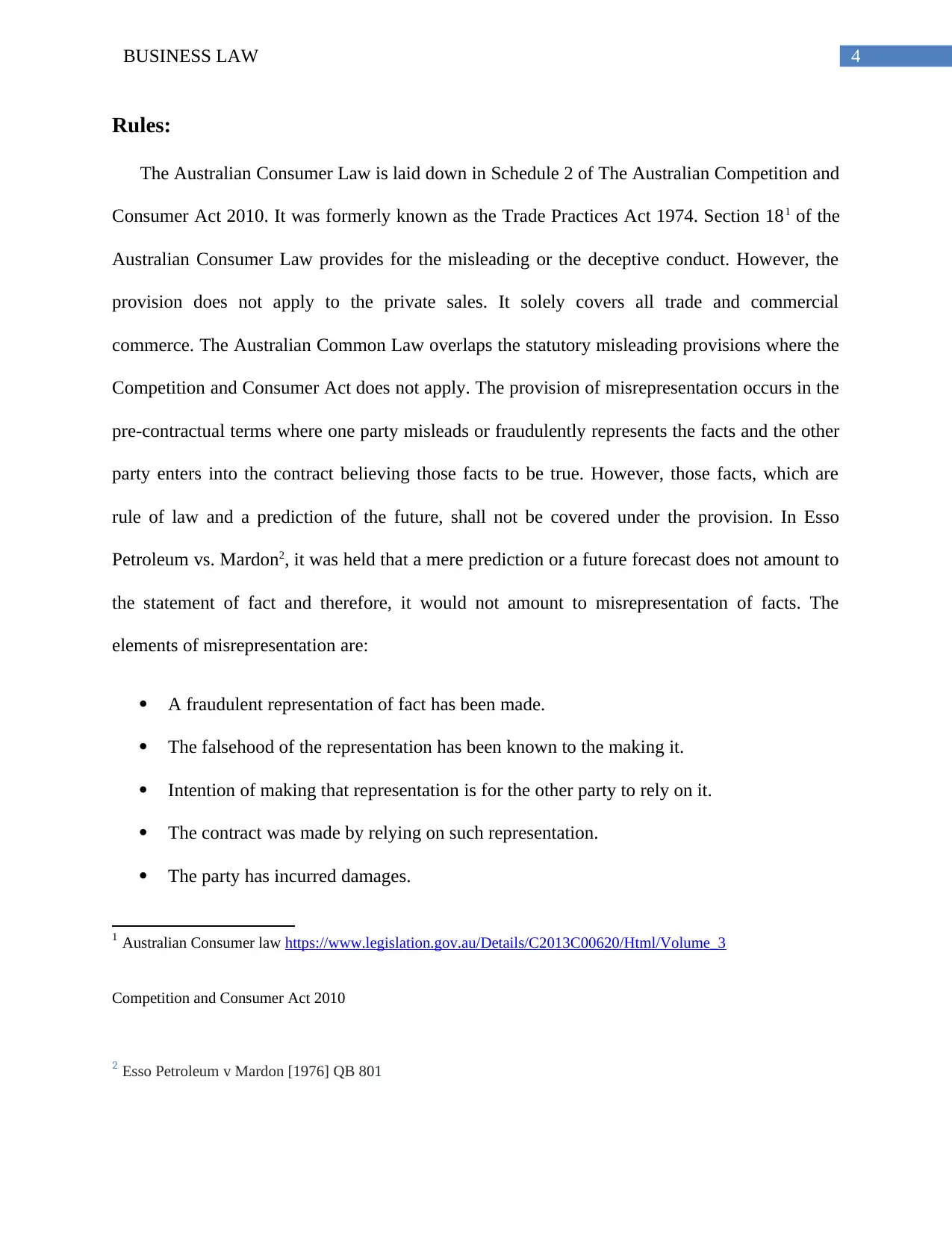
4BUSINESS LAW
Rules:
The Australian Consumer Law is laid down in Schedule 2 of The Australian Competition and
Consumer Act 2010. It was formerly known as the Trade Practices Act 1974. Section 181 of the
Australian Consumer Law provides for the misleading or the deceptive conduct. However, the
provision does not apply to the private sales. It solely covers all trade and commercial
commerce. The Australian Common Law overlaps the statutory misleading provisions where the
Competition and Consumer Act does not apply. The provision of misrepresentation occurs in the
pre-contractual terms where one party misleads or fraudulently represents the facts and the other
party enters into the contract believing those facts to be true. However, those facts, which are
rule of law and a prediction of the future, shall not be covered under the provision. In Esso
Petroleum vs. Mardon2, it was held that a mere prediction or a future forecast does not amount to
the statement of fact and therefore, it would not amount to misrepresentation of facts. The
elements of misrepresentation are:
A fraudulent representation of fact has been made.
The falsehood of the representation has been known to the making it.
Intention of making that representation is for the other party to rely on it.
The contract was made by relying on such representation.
The party has incurred damages.
1 Australian Consumer law https://www.legislation.gov.au/Details/C2013C00620/Html/Volume_3
Competition and Consumer Act 2010
2 Esso Petroleum v Mardon [1976] QB 801
Rules:
The Australian Consumer Law is laid down in Schedule 2 of The Australian Competition and
Consumer Act 2010. It was formerly known as the Trade Practices Act 1974. Section 181 of the
Australian Consumer Law provides for the misleading or the deceptive conduct. However, the
provision does not apply to the private sales. It solely covers all trade and commercial
commerce. The Australian Common Law overlaps the statutory misleading provisions where the
Competition and Consumer Act does not apply. The provision of misrepresentation occurs in the
pre-contractual terms where one party misleads or fraudulently represents the facts and the other
party enters into the contract believing those facts to be true. However, those facts, which are
rule of law and a prediction of the future, shall not be covered under the provision. In Esso
Petroleum vs. Mardon2, it was held that a mere prediction or a future forecast does not amount to
the statement of fact and therefore, it would not amount to misrepresentation of facts. The
elements of misrepresentation are:
A fraudulent representation of fact has been made.
The falsehood of the representation has been known to the making it.
Intention of making that representation is for the other party to rely on it.
The contract was made by relying on such representation.
The party has incurred damages.
1 Australian Consumer law https://www.legislation.gov.au/Details/C2013C00620/Html/Volume_3
Competition and Consumer Act 2010
2 Esso Petroleum v Mardon [1976] QB 801
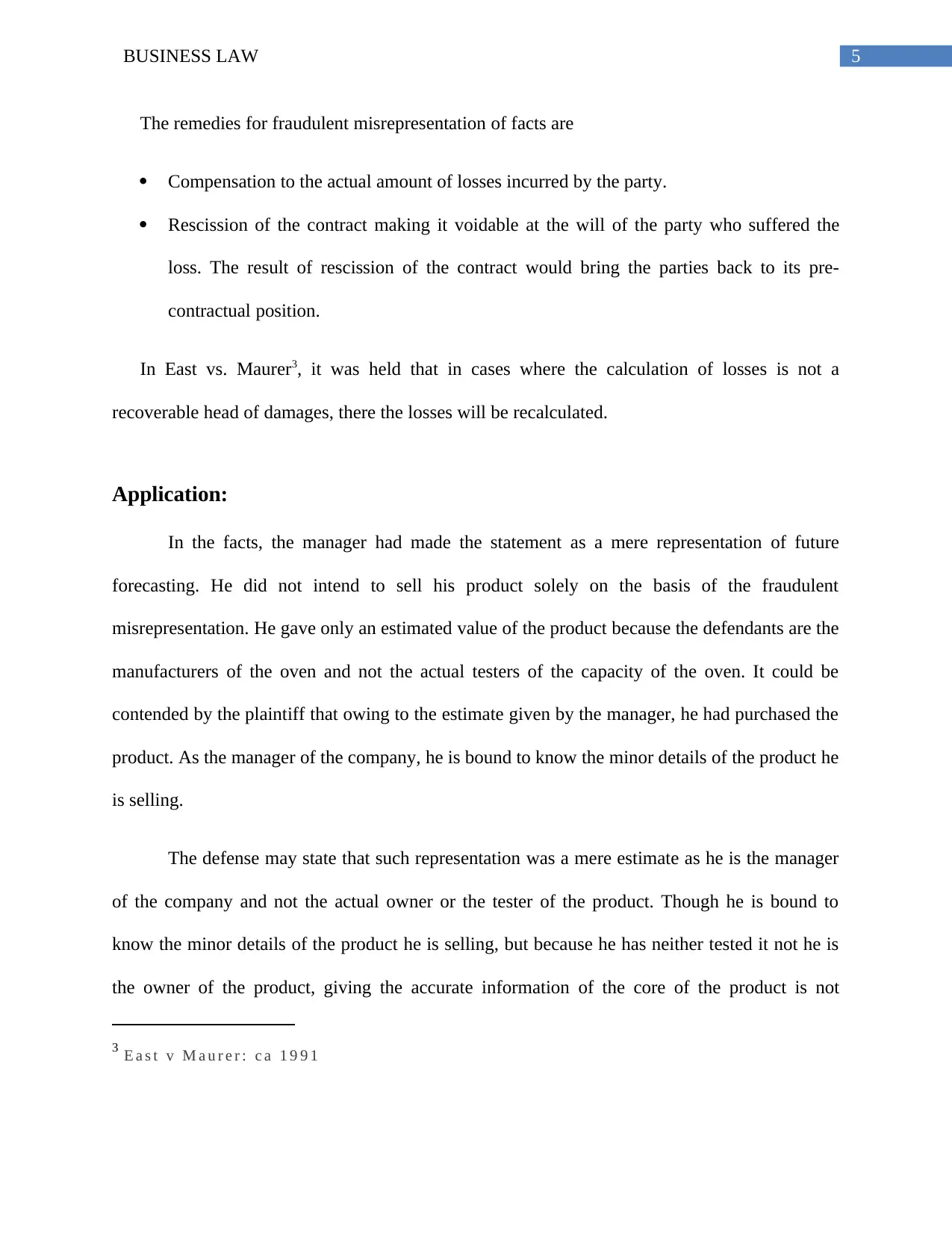
5BUSINESS LAW
The remedies for fraudulent misrepresentation of facts are
Compensation to the actual amount of losses incurred by the party.
Rescission of the contract making it voidable at the will of the party who suffered the
loss. The result of rescission of the contract would bring the parties back to its pre-
contractual position.
In East vs. Maurer3, it was held that in cases where the calculation of losses is not a
recoverable head of damages, there the losses will be recalculated.
Application:
In the facts, the manager had made the statement as a mere representation of future
forecasting. He did not intend to sell his product solely on the basis of the fraudulent
misrepresentation. He gave only an estimated value of the product because the defendants are the
manufacturers of the oven and not the actual testers of the capacity of the oven. It could be
contended by the plaintiff that owing to the estimate given by the manager, he had purchased the
product. As the manager of the company, he is bound to know the minor details of the product he
is selling.
The defense may state that such representation was a mere estimate as he is the manager
of the company and not the actual owner or the tester of the product. Though he is bound to
know the minor details of the product he is selling, but because he has neither tested it not he is
the owner of the product, giving the accurate information of the core of the product is not
3 E a s t v M a u r e r : c a 1 9 9 1
The remedies for fraudulent misrepresentation of facts are
Compensation to the actual amount of losses incurred by the party.
Rescission of the contract making it voidable at the will of the party who suffered the
loss. The result of rescission of the contract would bring the parties back to its pre-
contractual position.
In East vs. Maurer3, it was held that in cases where the calculation of losses is not a
recoverable head of damages, there the losses will be recalculated.
Application:
In the facts, the manager had made the statement as a mere representation of future
forecasting. He did not intend to sell his product solely on the basis of the fraudulent
misrepresentation. He gave only an estimated value of the product because the defendants are the
manufacturers of the oven and not the actual testers of the capacity of the oven. It could be
contended by the plaintiff that owing to the estimate given by the manager, he had purchased the
product. As the manager of the company, he is bound to know the minor details of the product he
is selling.
The defense may state that such representation was a mere estimate as he is the manager
of the company and not the actual owner or the tester of the product. Though he is bound to
know the minor details of the product he is selling, but because he has neither tested it not he is
the owner of the product, giving the accurate information of the core of the product is not
3 E a s t v M a u r e r : c a 1 9 9 1
⊘ This is a preview!⊘
Do you want full access?
Subscribe today to unlock all pages.

Trusted by 1+ million students worldwide
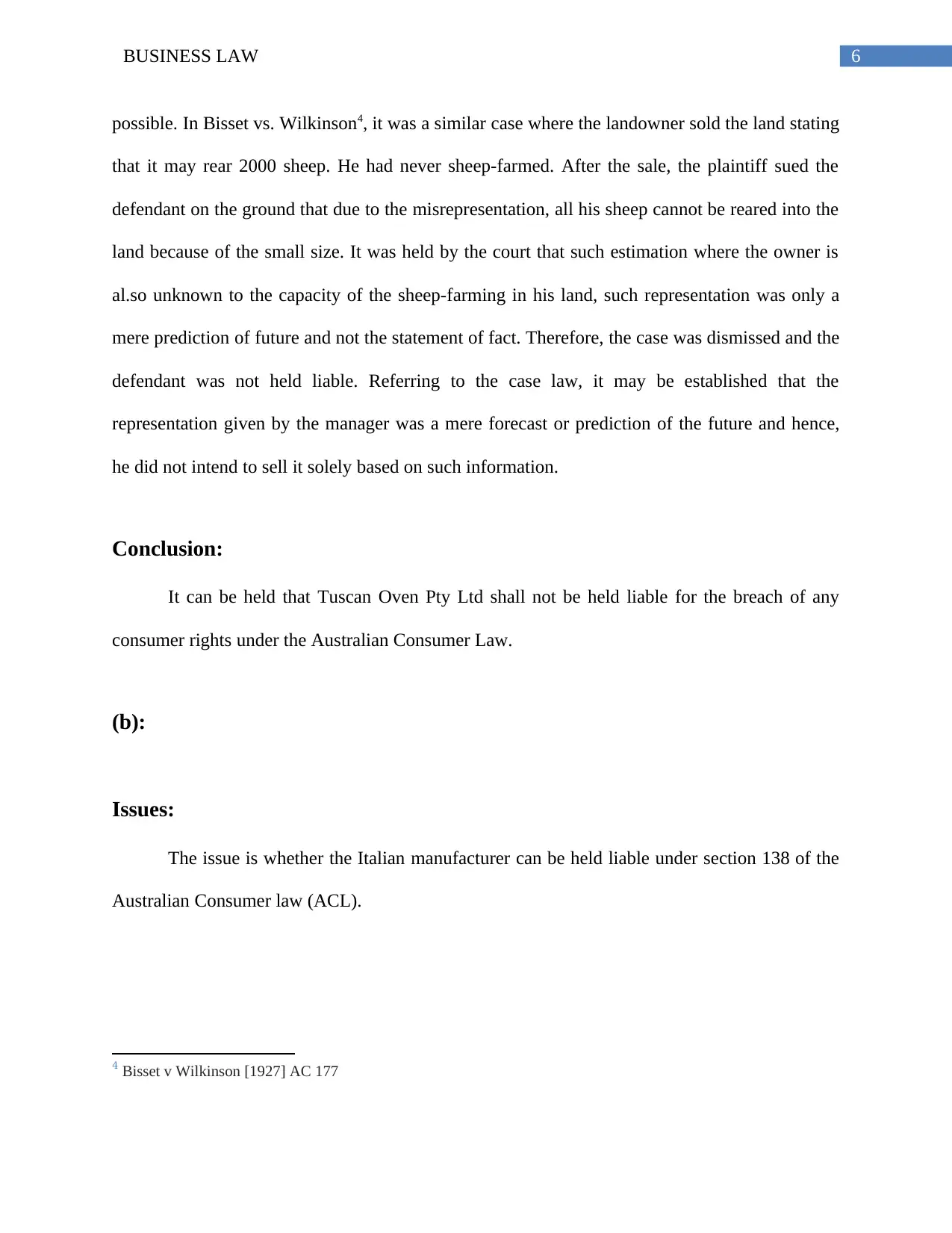
6BUSINESS LAW
possible. In Bisset vs. Wilkinson4, it was a similar case where the landowner sold the land stating
that it may rear 2000 sheep. He had never sheep-farmed. After the sale, the plaintiff sued the
defendant on the ground that due to the misrepresentation, all his sheep cannot be reared into the
land because of the small size. It was held by the court that such estimation where the owner is
al.so unknown to the capacity of the sheep-farming in his land, such representation was only a
mere prediction of future and not the statement of fact. Therefore, the case was dismissed and the
defendant was not held liable. Referring to the case law, it may be established that the
representation given by the manager was a mere forecast or prediction of the future and hence,
he did not intend to sell it solely based on such information.
Conclusion:
It can be held that Tuscan Oven Pty Ltd shall not be held liable for the breach of any
consumer rights under the Australian Consumer Law.
(b):
Issues:
The issue is whether the Italian manufacturer can be held liable under section 138 of the
Australian Consumer law (ACL).
4 Bisset v Wilkinson [1927] AC 177
possible. In Bisset vs. Wilkinson4, it was a similar case where the landowner sold the land stating
that it may rear 2000 sheep. He had never sheep-farmed. After the sale, the plaintiff sued the
defendant on the ground that due to the misrepresentation, all his sheep cannot be reared into the
land because of the small size. It was held by the court that such estimation where the owner is
al.so unknown to the capacity of the sheep-farming in his land, such representation was only a
mere prediction of future and not the statement of fact. Therefore, the case was dismissed and the
defendant was not held liable. Referring to the case law, it may be established that the
representation given by the manager was a mere forecast or prediction of the future and hence,
he did not intend to sell it solely based on such information.
Conclusion:
It can be held that Tuscan Oven Pty Ltd shall not be held liable for the breach of any
consumer rights under the Australian Consumer Law.
(b):
Issues:
The issue is whether the Italian manufacturer can be held liable under section 138 of the
Australian Consumer law (ACL).
4 Bisset v Wilkinson [1927] AC 177
Paraphrase This Document
Need a fresh take? Get an instant paraphrase of this document with our AI Paraphraser
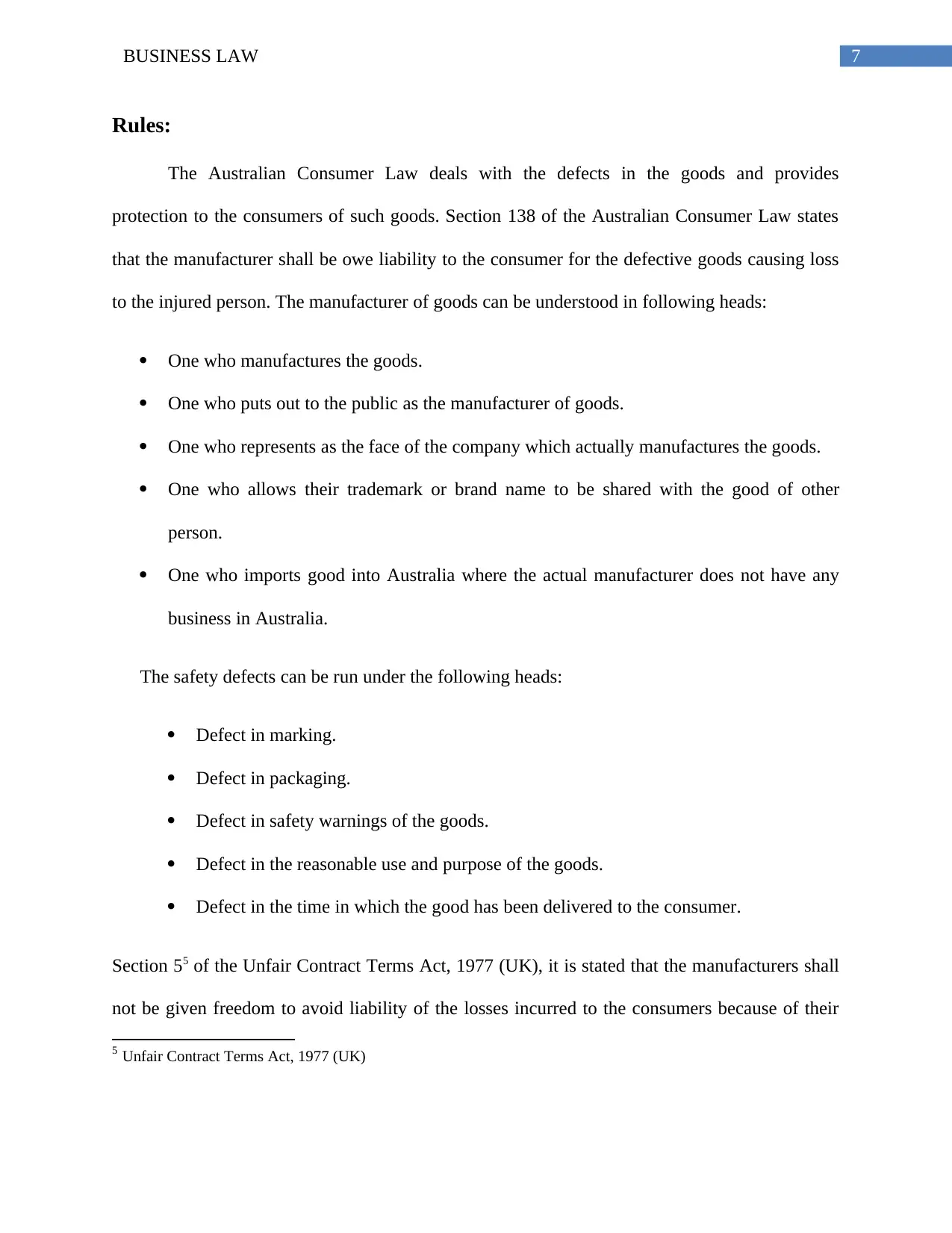
7BUSINESS LAW
Rules:
The Australian Consumer Law deals with the defects in the goods and provides
protection to the consumers of such goods. Section 138 of the Australian Consumer Law states
that the manufacturer shall be owe liability to the consumer for the defective goods causing loss
to the injured person. The manufacturer of goods can be understood in following heads:
One who manufactures the goods.
One who puts out to the public as the manufacturer of goods.
One who represents as the face of the company which actually manufactures the goods.
One who allows their trademark or brand name to be shared with the good of other
person.
One who imports good into Australia where the actual manufacturer does not have any
business in Australia.
The safety defects can be run under the following heads:
Defect in marking.
Defect in packaging.
Defect in safety warnings of the goods.
Defect in the reasonable use and purpose of the goods.
Defect in the time in which the good has been delivered to the consumer.
Section 55 of the Unfair Contract Terms Act, 1977 (UK), it is stated that the manufacturers shall
not be given freedom to avoid liability of the losses incurred to the consumers because of their
5 Unfair Contract Terms Act, 1977 (UK)
Rules:
The Australian Consumer Law deals with the defects in the goods and provides
protection to the consumers of such goods. Section 138 of the Australian Consumer Law states
that the manufacturer shall be owe liability to the consumer for the defective goods causing loss
to the injured person. The manufacturer of goods can be understood in following heads:
One who manufactures the goods.
One who puts out to the public as the manufacturer of goods.
One who represents as the face of the company which actually manufactures the goods.
One who allows their trademark or brand name to be shared with the good of other
person.
One who imports good into Australia where the actual manufacturer does not have any
business in Australia.
The safety defects can be run under the following heads:
Defect in marking.
Defect in packaging.
Defect in safety warnings of the goods.
Defect in the reasonable use and purpose of the goods.
Defect in the time in which the good has been delivered to the consumer.
Section 55 of the Unfair Contract Terms Act, 1977 (UK), it is stated that the manufacturers shall
not be given freedom to avoid liability of the losses incurred to the consumers because of their
5 Unfair Contract Terms Act, 1977 (UK)
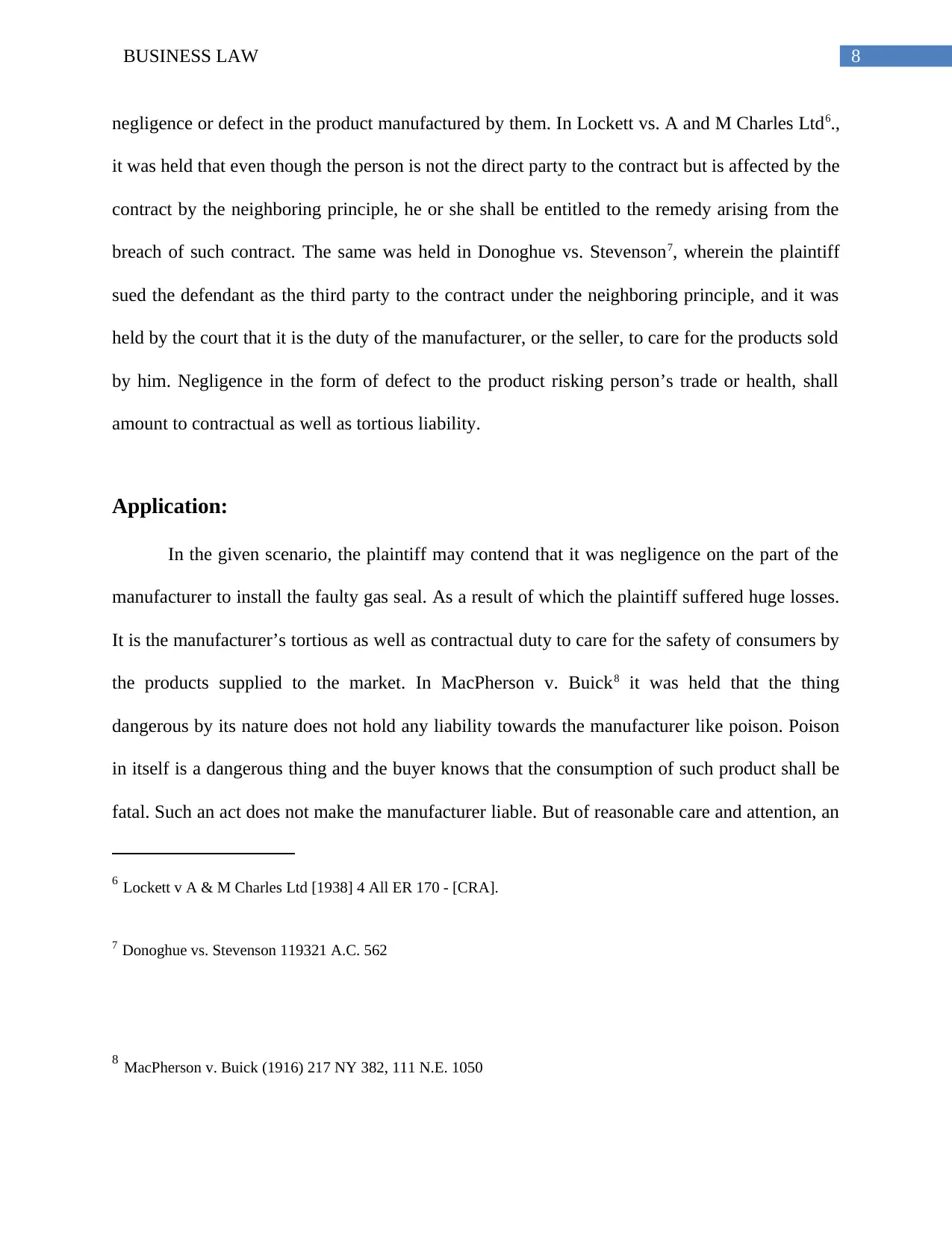
8BUSINESS LAW
negligence or defect in the product manufactured by them. In Lockett vs. A and M Charles Ltd6.,
it was held that even though the person is not the direct party to the contract but is affected by the
contract by the neighboring principle, he or she shall be entitled to the remedy arising from the
breach of such contract. The same was held in Donoghue vs. Stevenson7, wherein the plaintiff
sued the defendant as the third party to the contract under the neighboring principle, and it was
held by the court that it is the duty of the manufacturer, or the seller, to care for the products sold
by him. Negligence in the form of defect to the product risking person’s trade or health, shall
amount to contractual as well as tortious liability.
Application:
In the given scenario, the plaintiff may contend that it was negligence on the part of the
manufacturer to install the faulty gas seal. As a result of which the plaintiff suffered huge losses.
It is the manufacturer’s tortious as well as contractual duty to care for the safety of consumers by
the products supplied to the market. In MacPherson v. Buick8 it was held that the thing
dangerous by its nature does not hold any liability towards the manufacturer like poison. Poison
in itself is a dangerous thing and the buyer knows that the consumption of such product shall be
fatal. Such an act does not make the manufacturer liable. But of reasonable care and attention, an
6 Lockett v A & M Charles Ltd [1938] 4 All ER 170 - [CRA].
7 Donoghue vs. Stevenson 119321 A.C. 562
8 MacPherson v. Buick (1916) 217 NY 382, 111 N.E. 1050
negligence or defect in the product manufactured by them. In Lockett vs. A and M Charles Ltd6.,
it was held that even though the person is not the direct party to the contract but is affected by the
contract by the neighboring principle, he or she shall be entitled to the remedy arising from the
breach of such contract. The same was held in Donoghue vs. Stevenson7, wherein the plaintiff
sued the defendant as the third party to the contract under the neighboring principle, and it was
held by the court that it is the duty of the manufacturer, or the seller, to care for the products sold
by him. Negligence in the form of defect to the product risking person’s trade or health, shall
amount to contractual as well as tortious liability.
Application:
In the given scenario, the plaintiff may contend that it was negligence on the part of the
manufacturer to install the faulty gas seal. As a result of which the plaintiff suffered huge losses.
It is the manufacturer’s tortious as well as contractual duty to care for the safety of consumers by
the products supplied to the market. In MacPherson v. Buick8 it was held that the thing
dangerous by its nature does not hold any liability towards the manufacturer like poison. Poison
in itself is a dangerous thing and the buyer knows that the consumption of such product shall be
fatal. Such an act does not make the manufacturer liable. But of reasonable care and attention, an
6 Lockett v A & M Charles Ltd [1938] 4 All ER 170 - [CRA].
7 Donoghue vs. Stevenson 119321 A.C. 562
8 MacPherson v. Buick (1916) 217 NY 382, 111 N.E. 1050
⊘ This is a preview!⊘
Do you want full access?
Subscribe today to unlock all pages.

Trusted by 1+ million students worldwide
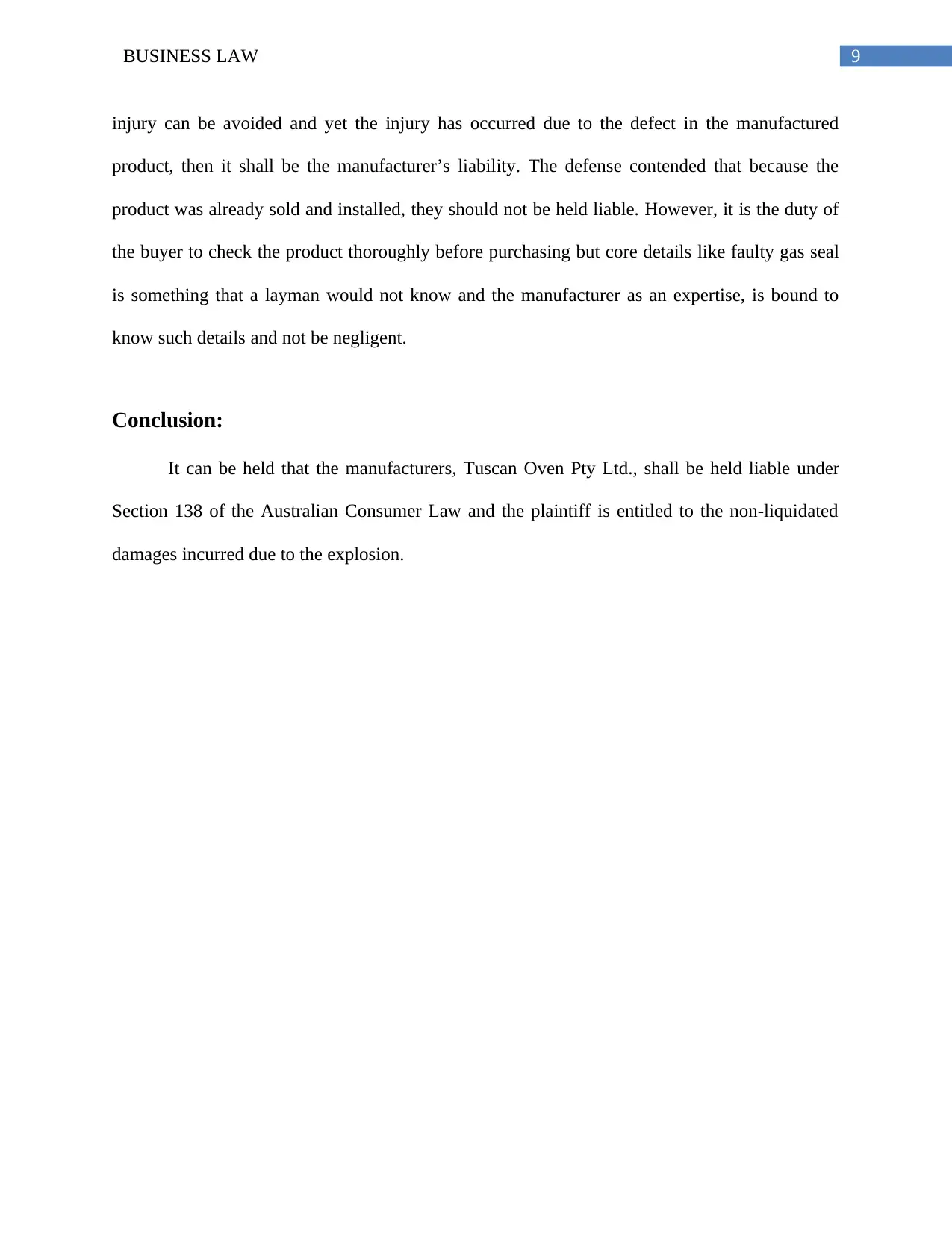
9BUSINESS LAW
injury can be avoided and yet the injury has occurred due to the defect in the manufactured
product, then it shall be the manufacturer’s liability. The defense contended that because the
product was already sold and installed, they should not be held liable. However, it is the duty of
the buyer to check the product thoroughly before purchasing but core details like faulty gas seal
is something that a layman would not know and the manufacturer as an expertise, is bound to
know such details and not be negligent.
Conclusion:
It can be held that the manufacturers, Tuscan Oven Pty Ltd., shall be held liable under
Section 138 of the Australian Consumer Law and the plaintiff is entitled to the non-liquidated
damages incurred due to the explosion.
injury can be avoided and yet the injury has occurred due to the defect in the manufactured
product, then it shall be the manufacturer’s liability. The defense contended that because the
product was already sold and installed, they should not be held liable. However, it is the duty of
the buyer to check the product thoroughly before purchasing but core details like faulty gas seal
is something that a layman would not know and the manufacturer as an expertise, is bound to
know such details and not be negligent.
Conclusion:
It can be held that the manufacturers, Tuscan Oven Pty Ltd., shall be held liable under
Section 138 of the Australian Consumer Law and the plaintiff is entitled to the non-liquidated
damages incurred due to the explosion.
Paraphrase This Document
Need a fresh take? Get an instant paraphrase of this document with our AI Paraphraser
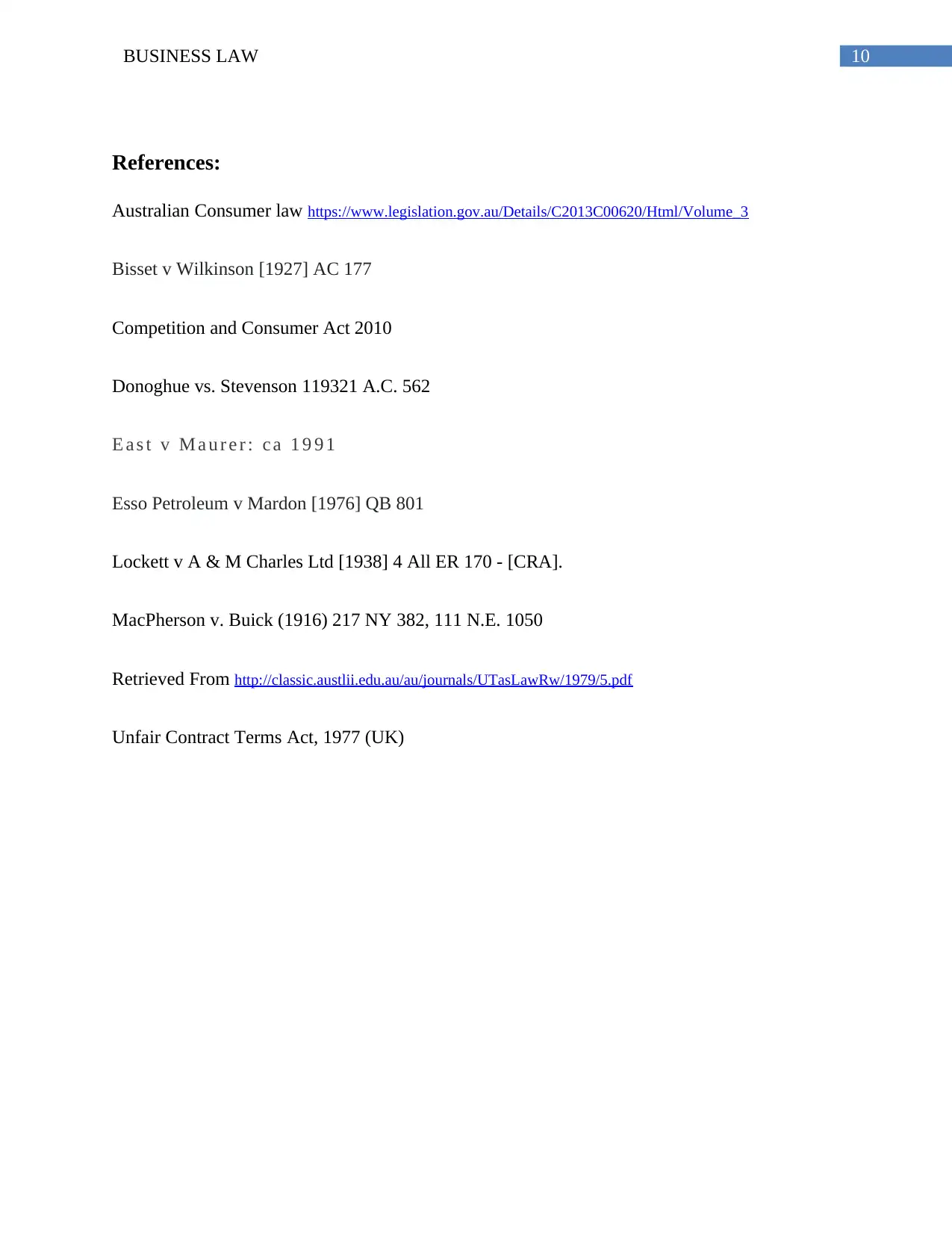
10BUSINESS LAW
References:
Australian Consumer law https://www.legislation.gov.au/Details/C2013C00620/Html/Volume_3
Bisset v Wilkinson [1927] AC 177
Competition and Consumer Act 2010
Donoghue vs. Stevenson 119321 A.C. 562
E a s t v M a u r e r : c a 1 9 9 1
Esso Petroleum v Mardon [1976] QB 801
Lockett v A & M Charles Ltd [1938] 4 All ER 170 - [CRA].
MacPherson v. Buick (1916) 217 NY 382, 111 N.E. 1050
Retrieved From http://classic.austlii.edu.au/au/journals/UTasLawRw/1979/5.pdf
Unfair Contract Terms Act, 1977 (UK)
References:
Australian Consumer law https://www.legislation.gov.au/Details/C2013C00620/Html/Volume_3
Bisset v Wilkinson [1927] AC 177
Competition and Consumer Act 2010
Donoghue vs. Stevenson 119321 A.C. 562
E a s t v M a u r e r : c a 1 9 9 1
Esso Petroleum v Mardon [1976] QB 801
Lockett v A & M Charles Ltd [1938] 4 All ER 170 - [CRA].
MacPherson v. Buick (1916) 217 NY 382, 111 N.E. 1050
Retrieved From http://classic.austlii.edu.au/au/journals/UTasLawRw/1979/5.pdf
Unfair Contract Terms Act, 1977 (UK)
1 out of 11
Related Documents
Your All-in-One AI-Powered Toolkit for Academic Success.
+13062052269
info@desklib.com
Available 24*7 on WhatsApp / Email
![[object Object]](/_next/static/media/star-bottom.7253800d.svg)
Unlock your academic potential
Copyright © 2020–2025 A2Z Services. All Rights Reserved. Developed and managed by ZUCOL.





